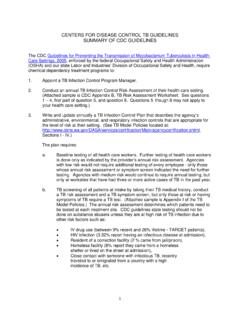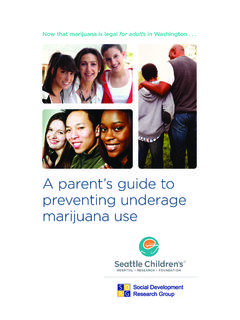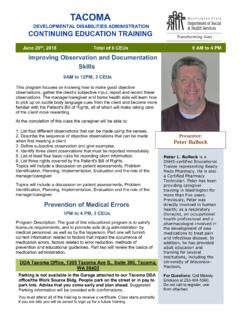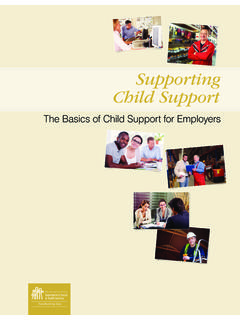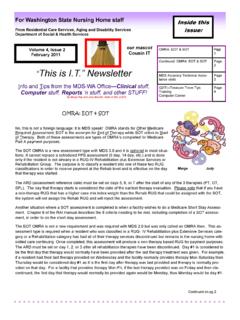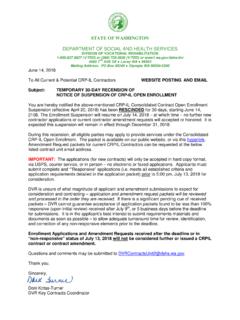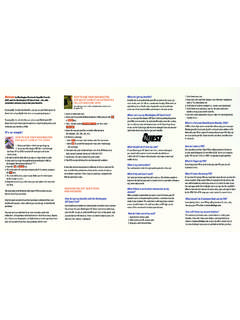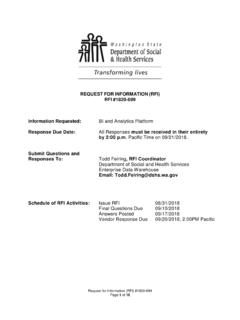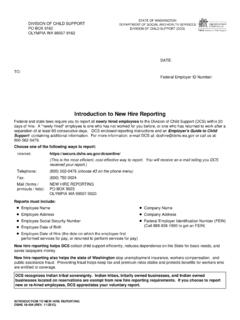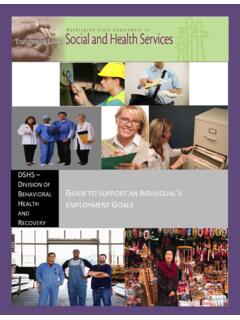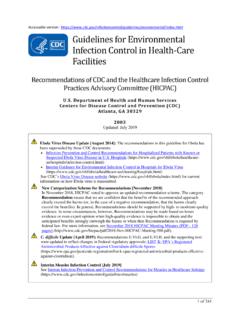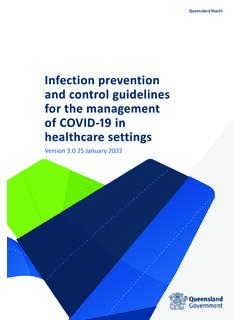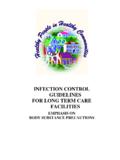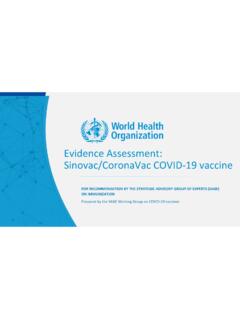Transcription of Safe Start: Long Term Care (LTC) COVID Response Plan
1 Safe Start: Long Term Care (LTC) COVID Response Plan Nursing Homes and Intermediate Care Facilities for Individuals with Intellectual Disabilities October 07, 2021 Safe Start: LTC COVID Response Plan 1. The information contained in this Safe Start: LTC COVID Response Plan is independent of any other Washington State plan. 2. Facilities and homes are required to follow this Safe Start: LTC COVID Response Plan. 3. The impact of COVID -19 vaccines on community transmission rates may allow for future changes to the recommendations and requirements in the Safe Start: LTC COVID Response Plan. Contents LTC Facility Recommendations and Requirements Residential Care Setting Safe Start Requirement Core Principles of COVID -19 Infection Prevention Screening PPE and Source control Federal and State Disability Laws Medical Necessary Providers, Service and Health Care Workers Principles Communal Activities and Dining Principles Offsite Visits and New Admissions Care Plans Continuing Care Retirement Communities (CCRC)
2 And Independent Living Campuses Access to Ombuds and Resident Rights Advocates Visitation Outdoor Visitation Principles Outside Safety Related to Structures CMS Indoor Visitation Principles CMS Compassionate Care Principles Essential Support Person Visitation During an Outbreak Visitor Log Information Additional Resources Introduction Safe Start: Long-Term Care (LTC) COVID Response Plan Recommendations and Requirements The Department of Social and Health Services (DSHS) and the Department of Health (DOH) are presenting the updated safe start plan for licensed and certified long-term care facilities and agencies.
3 Given the critical importance of limiting COVID -19 exposure in long-term care residential care settings and certified supported living agencies, decisions on relaxing restrictions are be made: With careful review of various unique aspects of the different facilities and communities in which they reside;. In alignment with the Governor's Proclamations; and In collaboration with state and local health officials. This approach will help keep residents and clients healthy and safe. Because the pandemic is affecting communities in different ways, DSHS, DOH and the Governor's Office regularly monitor the factors for the Safe Start for LTC and adjust the Washington plans accordingly.
4 Residential Care Setting Safe Start Requirements 1. Follow the Centers of Disease control and Prevention (CDC), Department of Health (DOH), and local health jurisdictions' (LHJs) (when applicable). infection control guidelines to slow COVID -19 spread. 2. If there is a difference between state and federal guidance follow the more restrictive guidance. For questions regarding guidance consult with the LHJ or email 3. Cooperate with the local health officer or his/her designee in the conduct of an outbreak investigation, including compliance with all recommended or ordered infection prevention measures, testing of staff, and testing of residents.
5 4. Follow this DSHS and DOH Safe Start LTC COVID Response document. This document is guidance for LTC and is not included in any other Washington State plan 5. Individual facility types have state statute or rules that requires a facility to impose actions to protect the residents by activating their infection control plan. 6. The LHJ or DOH have the authority to institute infection prevention and control measures in Response to any infectious disease and/or COVID -19. outbreak. The LHJ and DOH under WAC 246-101-505 and WAC 246-101-605 have the authority to conduct public health investigations and institute control measures and, pursuant to WAC 246-101-305, LTCs are obligated to cooperate with these investigations.
6 Please refer to the DOH definition of an outbreak found here: Interim COVID -19 Outbreak Definition for Healthcare Settings All facilities and agencies must be prepared for an outbreak and make assurances they have;. Safe Start for Nursing Facilities and Intermediate Care Facilities for Individuals with Intellectual Disabilities Page 2 of 16. Revised 10/07/2021. 1. The facility must maintain access to COVID -19 testing for all residents and staff: a. Aiming for fast turnaround times, ideally less than 48 hours, b. Testing all residents/clients with signs and symptoms of COVID -19 or with identified exposures, c.
7 Working with local and state public health to coordinate repeat and outbreak testing, and d. Capacity to conduct ongoing, serial testing of clients and staff according to federal, state and local guidance;. e. Testing includes point of care antigen testing and PCR lab testing. f. Nursing Homes follow CMS guidance in QSO memo 20-38 or DOH or LHJ guidance, whichever is more stringent. 2. A Response plan to inform cohorting and other infection control measures;. 3. A plan to screen all staff following the symptom screening strategies that can be found here: Infection control Guidance | CDC and to screen all visitors using the DOH Supplemental Guidance for Long-term Care Facility Visitors.
8 4. Dedicated space for cohorting and managing care for residents with COVID -19 or if unable to cohort residents, and a plan which may include transferring a person to another care setting;. 5. A plan in place to care for residents with COVID -19, including identification and isolation of residents. The facility or agency plan must describe the identification, care and isolation of residents or clients may be requested by DSHS, DOH or the LHJs to conduct an outbreak investigation. Technical assistance for development of these plans can be received from LHJs. 6. Protected and promoted resident and client rights while following standards of infection control practices including when a resident or a client requires quarantine or isolation due to individual disease status or an outbreak in a residential facility or client home.
9 CMS Key Visitation Principles (QSO Memo 20-39). Visitation, in conjunction with LTC Safe Start Recommendations, can be conducted through different means based on a facility's structure and residents' needs, such as in resident rooms, dedicated visitation spaces, outdoors, and for circumstances beyond compassionate care situations. Regardless of how visits are conducted, there are certain core principles and best practices that reduce the risk of COVID -19 transmission: QSO-20-39-NH REVISED ( ). Core Principles of COVID -19 Infection Prevention Screening of all who enter the facility for signs and symptoms of COVID -19 and denial of entry of those with signs or symptoms Hand hygiene (use of alcohol-based hand rub is preferred).
10 Face covering or mask (covering mouth and nose). Social distancing at least six feet between persons Instructional signage throughout the facility and proper visitor education on COVID19 signs and symptoms, infection control precautions, other applicable facility practices ( , use of face covering or mask, specified entries, exits and routes to designated areas, hand hygiene). Cleaning and disinfecting high frequency touched surfaces in the facility often, and designated visitation areas after each visit Appropriate staff use of Personal Protective Equipment (PPE). Effective cohorting of residents ( , separate areas dedicated COVID -19 care).
